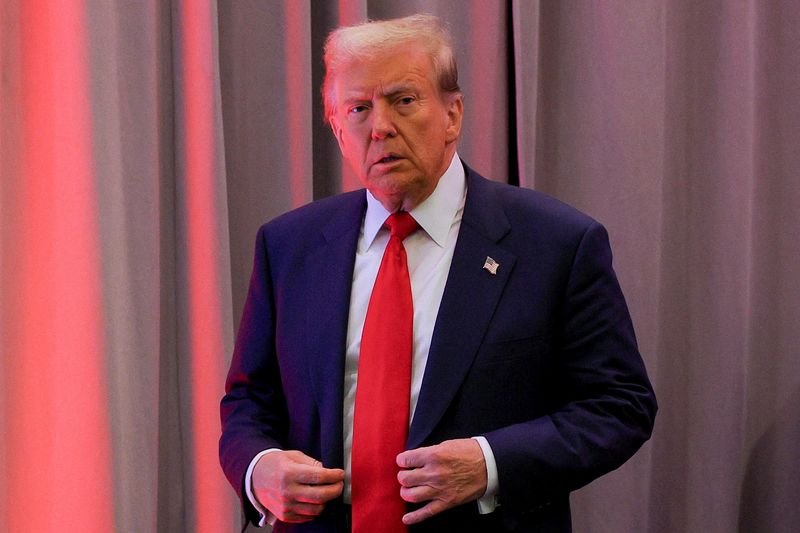Analysis-In choosing his team, Trump opts for personal ties and TV chops

By James Oliphant and Helen Coster
WASHINGTON (Reuters) – In staffing his incoming administration, President-elect Donald Trump has so far veered from the conventional to the confounding. But his choices all seem to have one thing in common: A bond with Trump himself.
From his chief of staff to those he’s tapped to lead the Justice Department, the Pentagon and Department of Homeland Security, Trump is picking people who have been familiar faces at his campaign rallies, frequent visitors to his Mar-a-Lago resort in Florida or reliable defenders of him on TV.
It’s a sharp contrast from his first go-round in the White House, when Trump, then a neophyte Republican politician, ended up with members on his team with whom he had no prior working relationship and no level of trust.
For Trump 2.0, the president-elect is rewarding his staunchest allies with plum roles. Some have almost no relevant experience for their positions, and a few could face a difficult Senate confirmation process even with a Republican majority.
Trump has tapped Pete Hegseth, a Fox News personality with no administrative experience, to oversee the sprawling Pentagon; nominated Matt Gaetz, a longtime conservative provocateur who lacks a law-enforcement background as attorney general; and asked the governor of rural South Dakota, Kristi Noem, to be the nation’s top Homeland Security official.
He also has tasked billionaire Elon Musk and former presidential candidate Vivek Ramaswamy, Trump rally mainstays, with streamlining the federal bureaucracy although neither has ever worked in government.
The picks suggest that Trump, as is his style, prefers the hammer to scalpel, and wants to show his political base that he is following through on his campaign pledges to deport millions of migrants, investigate his political adversaries and rid the military of “woke” policies on gender and diversity.
“It’s noteworthy that the people that he’s selected for the most prominent positions tend to be people who are, I would say, good on television, so they’re good on the sort of public-facing side of those jobs,” said David Lewis, a professor at Vanderbilt University who has written a book on presidential appointments.
“I think there (are) some questions about whether the folks that he has selected have the experience managing large bureaucracies and have all of the substantive expertise they need to do those jobs,” Lewis added.
Trump’s choices of Hegseth and Gaetz were among those that were met with skepticism and surprise among some leaders in Washington.
Various administration hopefuls have been steadily making their way to Palm Beach to meet with Trump’s transition team at Mar-a-Lago and to try to steal a moment with Trump himself.
“Sometimes you just need to catch him on the patio,” said one source close to Trump’s team.
A Trump donor said the president-elect and his allies have huddled in a room with TVs and pictures of prospective appointees. “I hear Trump is watching a lot of TV clips,” the donor said, “looking at: How will these people defend me on TV?”
NO MORE STRANGERS
After Trump’s 2016 win, he called upon strangers such as Rex Tillerson, the former CEO of ExxonMobil, to helm the State Department, and Jim Mattis, a retired general, to head up the Pentagon. He named an outsider, Reince Priebus, who was chair of the Republican National Committee, as his chief of staff.
Trump eventually became disillusioned and replaced Tillerson and Mattis, and cycled through four chiefs of staff during his first term.
This time around, he seems determined to avoid similar missteps. Trump has had four years to learn the job of chief executive and better understand what he wants from his appointees.
He quickly named Susie Wiles, his trusted co-campaign manager, as his chief of staff. He chose Tom Homan, who ran the U.S. Immigration and Customs Enforcement agency during Trump’s first term, to be his “border czar” in charge of the mass deportations of migrants that Trump has promised. He tapped John Ratcliffe, who previously served as Trump’s director of national intelligence, to now become CIA director.
“In many ways, President Trump was able to run a four-year university in term one that has allowed him to provide training to so many people who are now aligned with his agenda,” said Matt Mowers, a former U.S. State Department official and a Republican strategist.
Observers say Trump’s approach to appointments has been noticeably more efficient than eight years ago, when he sacked his transition chair, former New Jersey Governor Chris Christie, over disagreements on personnel.
“It seems to be a much more orderly process and without the chaos of having fired the transition chief and tossing their work,” said Kathryn Dunn Tenpas, an expert in presidential staffing at the Brookings Institution.
Trump’s latest picks on Wednesday again included loyalists who made the rounds for him on the trail and TV during his successful campaign – and are unlikely to push back against his plans for his second term.
Trump announced U.S. Senator Marco Rubio, a former rival who has deep experience in foreign policy and intelligence issues, as his secretary of state. Rubio has softened some of his stances over the last several years to align more closely with Trump’s views.
Trump also selected Tulsi Gabbard, a former Democratic congresswoman who grew popular with conservatives for supporting isolationist policies and showing disdain for “wokeness,” as his director of national intelligence.
Gabbard has little direct experience with intelligence work. But she made a home for herself on Fox News and other conservative channels, and likely soon will be defending Trump on the air again in her new role.
(Reporting by James Oliphant in Washington and Helen Coster in New York. Additional reporting by Alexandra Ulmer and Gram Slattery.; Editing by Colleen Jenkins and Deepa Babington)